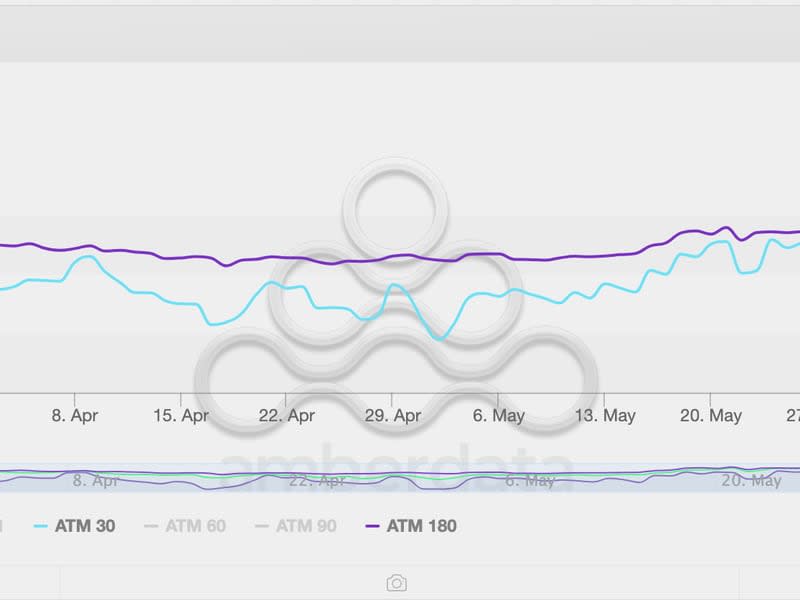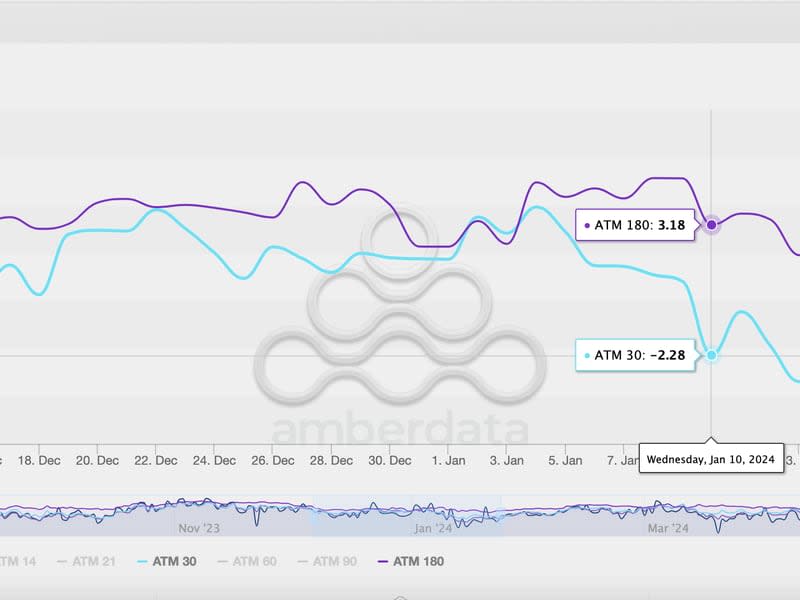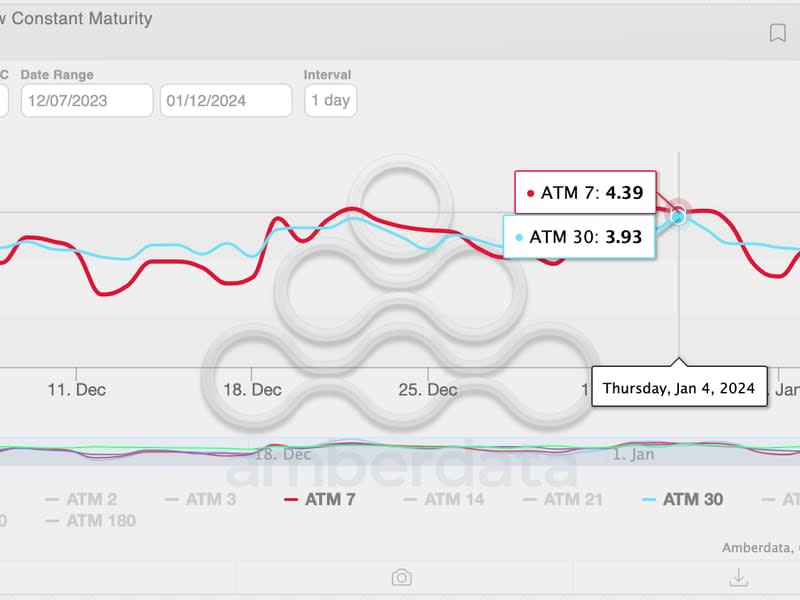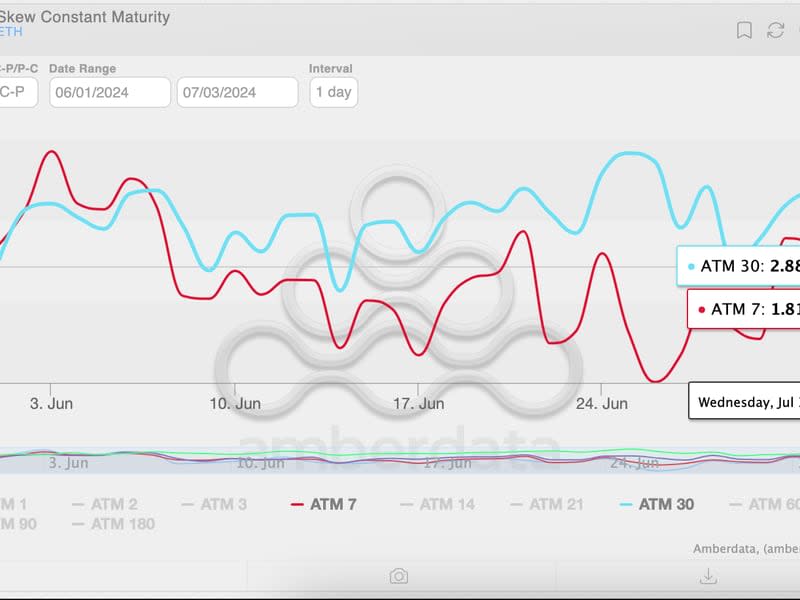Pre-ETF Ether Options Trend Mirrors BTC Except for One Key Difference
Ether's options market shows a bullish bias over the 30-day and six-month period ahead of the ETF launch, mirroring bitcoin market trends in January.
Ether's market, however, shows no signs of bullish euphoria.
The measured bullish sentiment might lead to ether outperformance later.
The much-anticipated U.S. exchange-traded funds (ETF) that directly invest in ether {{ETH}} are expected to begin trading in mid-July.
Ahead of the debut, trends in the ether options market on Deribit closely mirror the sentiment in bitcoin {{BTC}} options in the lead-up to the BTC ETFs six months ago, except for one key difference that may be pivotal to traders.
At press time, ether's 30-day options skew, which measures what traders are willing to pay for an asymmetric payout in the upward or downward direction, held around 3%, according to Amberdata.
The positive value indicated a willingness to pay relatively more for call options, offering buyers an asymmetric payout in the upward direction over the next four weeks. A call gives the holder the right to buy an underlying asset at a preset price within a specific time frame and represents a bullish bet. A put represents a bearish bet.
Ether calls expiring in six months also traded at a premium relative to puts, with the skew hovering at around 5%.

In other words, traders are using options to position for ether strength heading into the ETF debut and over the next six months. Traders pursued a similar strategy roughly two weeks before BTC ETFs began trading on Jan. 11. In early January, BTC's 30-day and 180-day skews were around 3.5% and 5%, respectively.
The bullish positioning in the ether market is consistent with expectations that spot ether ETFs, which allow investors to take exposure to the asset without owning it, will unlock mainstream institutional demand worth billions of dollars. BTC ETFs have attracted net inflows of over $14 billion to date, per Farside Investors.
"The upcoming ETH ETF launches are likely to have a much more material impact in ETH as it brings a new wave of investors. With ETH's supply being highly concentrated in long-term players, ETF inflows could have an outsized effect if they are proportionally as large as the one's Bitcoin received," analytics firm IntoTheBlock said in the latest edition of the weekly newsletter.
Sell the fact?
Bitcoin's 30-day options skew flipped bearish on Jan. 10, signaling a renewed bias for puts in a sign of traders prepping for a classic sell-the-fact pullback after the debut of ETFs.

BTC's price did fall by over 15% by Jan. 23, testing lows under $40,000 before rallying to new record highs above $70,000 in March.
So, ether traders might want to watch for a potential bearish flip in the 30-day options skew in the next few days.
No signs of euphoria
The one difference in how ether options are currently priced compared to bitcoin in January suggests the ether market is not as euphoric as BTC was seven months ago. That perhaps weakens the case for a sell-the-fact pullback.
BTC's seven-day skew showed a stronger bias for calls than the 30-day skew several times ahead of the ETF debut, a sign of heightened optimism or expectations of a price increase soon.

Usually, investors expect higher uncertainty or volatility in the distant future compared to the near term, ensuring longer duration skews return a higher value than shorter ones. That's the case in the ether market, where the 7-day skew remains below the 30-day skew, exhibiting a relatively measured bullish bias.

Note that the broader market mood is more somber than in late 2023 and early January. Ether has declined from $4,000 to $3,350 since late May, having failed to keep pace with bitcoin's rally to new record highs in the first quarter.
That's probably because several analysts are unsure the demand for ether ETFs will match the benchmark set by bitcoin ETFs. "Bitcoin had the first mover advantage, potentially saturating the overall demand for crypto assets in response to spot ETF approvals,” analysts at JPMorgan, led by Nikolaos Panigirtzoglou, said in May, adding that ether ETFs could see $3 billion in net inflows this year.
According to Ilan Solot, senior global market strategist at Marex Solutions, the pessimism might actually lead to ether outperformance.
"The ubiquitous pessimism is a strong set-up for outperformance. Same for the sell the news strategy, many will try to replay from the BTC ETF," Solot said in an email.
"However, I fear many inflow predictions could be over-benchmarked by comparing them to the BTC ETF numbers (like “ETH will attract 20% of BTC ETF inflows”). The prevalence of delta-neutral trades [carry trades] may muddle the comparison and overestimate potential price impacts."
8:52 UTC: Corrects Solot's title to senior global market strategist. The previous version said co-head of digital assets.


